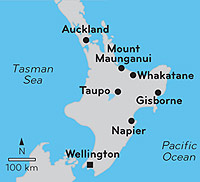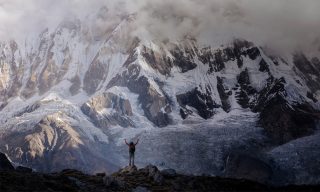“Heaps of sheep, brah. Heaps of sheep.” This is Tom Loughlin speaking, as he gazes across the high-country pastureland of a ranch on the island’s Central Plateau. Thickset, unshaven, and with the look of a woodsman about him, Tom is to be my Maori guide for the afternoon, and he’s eager to get moving. “They already laid the hangi at the whare,” he says. “Jump in the truck—that car of yours won’t get you very far.”
I’m more than an hour late for our appointment, largely because I had difficulty pulling myself away from the comforts of the Farm. But I don’t dare tell Tom that. Instead, I just apologize again and mumble something about traffic, which Tom shrugs off as the barefaced lie that it is. “No worries, brah. We’ll get you there.”
There turns out to be a lone house (whare) deep in the backcountry, a drive that takes us across the ranch and into the tribal lands of the Tuwharetoa people. It’s remarkable terrain—an undulating, dun-hued landscape of manuka scrub and deep gullies. As we bounce along the dirt track, Tom, in his forties, tells me that five generations of his family have lived and hunted in these mountains. He came here on camping trips as a boy, and fished for eels in the Ripia River. “There used to be seasonal Maori communities on this land,” he says, dropping the four-by-four into low gear to clear a dry streambed. “But not anymore. Everyone lives in the cities now.”
Yet Tom, who runs a small tour company called the Kai Waho Experience, has maintained an old hunting cabin up here, at 900 meters above sea level. Fixed up for guests, it now serves as the base camp for his unique, authentic immersions into the traditional Maori way of life. Kai waho, he explains, translates as “outdoor food,” and his three- to four-day outback adventures see guests living off the land, foraging, hunting, and cooking food in the manner of his Maori forefathers.
A former chef, Tom has also designed shorter itineraries for day-trippers like me. These revolve around preparing a feast in a hangi, or cooking pit. By the time we arrive at Tanau Pa, Tom’s green-trimmed cabin, the food is ready to be dug up. “Just in time mate,” he says, offering me a cold beer and introducing me to the rest of his small group, which includes the manager of the neighboring ranch, one of his Maori ranch hands, and an older couple from Auckland. “Come, let’s get her up.”
We lower our heads reflexively as Tom intones a prayer of thanks. The next thing I know, there’s a shovel in my hands and I’m digging away at the hot sand covering the hangi. It doesn’t take long to unearth a layer of sackcloth, which Tom gently removes, unveiling our lunch: a steaming assemblage of vegetables and meat, wrapped in woven mats or tinfoil. At the bottom of the pit, in a bed of smoldering manuka-wood ash, a dozen rocks are still glowing with heat.
We carry the food into Tom’s kitchen, where he scoops it all onto platters, buffet-style: native squash, watercress, mussels from the Coromandel Peninsula, pikopiko (bush asparagus), lamb, wild pork, a whole chicken. Another prayer follows, and then we take our seats around a big dining table. “Enjoy your first hangi,” Tom says. “Some ingredients are modern, but the method is traditional.”
The cool mountain air has given me an appetite: I polish off two platefuls of food, and am casting a covetous eye at the remaining mussels when Tom calls me outside. I follow him down to the base of the property, where he picks up some shards of obsidian from what looks like an archeological dig. “My people used to trade this for fish with Maori from the coast,” he explains. “We’re right on an ancient trade route here.”
Then he steps toward me. “I have something else I want to share with you. It’s called the hongi.” And with that, he gently presses his nose and forehead against mine, in the customary Maori greeting. I might have blushed if it didn’t feel so much like a benediction.
By the time I make it back to my car and onto the highway again, it’s getting late. Fortunately, I don’t have far to drive—it’s just 20 minutes to where Steve Smith is waiting in his white pickup truck to guide me down an access road to Poronui, the lodge he manages.
“So you met Tom?” Steve says. “Great guy, an amazing experience. We recommend Kai Waho to all our guests. After all, we’re pretty much neighbors.”It’s a big neighborhood. Poronui alone spans 6,500 hectares, a vast tract of old-growth beech forest and grassland bisected by a trout stream. The lodge itself has evolved from a rustic fishing camp, and now ranks among the country’s top destinations for anglers and hunters. “This is the real thing—true Kiwi backcountry,” Steve says.
I’m staying in one of his timber guest cabins, which are arranged above a bend in the river. They’re spare compared to the accommodations at the Farm, but cozy; I don’t fully appreciate the fireplace until I wake the next morning to find a thick layer of frost on my balcony. And when Steve takes me on a tour of the property, I’m dazzled by the scenery, all the more so when a sika buck bounds across our path.
When it’s time to leave, I make my own way back to the highway, and point the car toward the lakeside town of Taupo, where I’ll rejoin State Highway 1 for the drive back to Auckland. As the kilometers click away, I do a mental checklist of my trip so far: glowworms and wild deer; seaside highways and roadside oysters; waiting for dawn on Wainui Beach; rubbing noses with a Maori. And for a moment I toy with the idea of turning south instead, and discovering what else this island—and maybe even the next island over—might hold in store. But that’s another story.
THE DETAILS:
New Zealand
Getting There
Singapore Airlines (singaporeair.com) flies daily to Auckland from Singapore.
Where to Stay
In Auckland, book a stay at the 25-room Hotel DeBrett (2 High St.; 64-9/925-9000; hoteldebrett.com; doubles from US$103) for designer-savvy digs and a top-notch kitchen. Jim and Lorraine Robertson’s aptly named Beachside B&B (21B Oceanbeach Rd., 64-7/574-0960; beachsidebnb.co.nz; from US$73) is among the best-kept guesthouses in Mount Maunganui, while Gisborne’s Emerald Hotel (15 Gladstone Rd.; 64-6/868-8055; emeraldhotel.co.nz; doubles from US$214) leads the pack in that city.
For luxury and location, the Farm at Cape Kidnappers (446 Clifton Rd., Te Awanga, Hawke’s Bay; 64-6/875-1900; capekidnappers.com; doubles from US$914) is hard to beat; the property includes a golf course, an excellent spa, and a romantic dining terrace (gentlemen, pack a jacket). Poronui (64-7/384-2080; poronui.com; doubles from US$833), situated near Taupo, is another top lodge, one designed with the sportsman in mind. The regular cabins are all about high-country comfort, while the four-bedroom Blake House, located deeper into the property, is the ultimate in secluded luxury.
What to Do
Tom Loughlin’s Kai Waho Experience (kaiwaho.co.nz) offers an intimate and authentic introduction to Maori traditions; it’s a must-do on any North Island itinerary. For kayaking, canoeing, and glowworm gazing, Waimarino (waimarino.com) is an excellent outfit based in Tauranga.
Originally appeared in the October/November 2010 print issue of DestinAsian magazine (“Northern Exposure”)










